A Wideband Folded Dipole Antenna with an Improved Cross-Polarization Level for Millimeter-Wave Applications
Abstract
:1. Introduction
2. Materials and Methods
2.1. Configuration of the Folded Dipole
2.2. The Principle of the Dual Mode Operation
2.3. Improvement of Cross-Polarization
3. Results
4. Conclusions
Author Contributions
Funding
Institutional Review Board Statement
Informed Consent Statement
Data Availability Statement
Conflicts of Interest
References
- Alhalabi, R.A.; Rebeiz, G.M. High-efficiency angled-dipole antennas for millimeter-wave phased array applications. IEEE Trans. Antennas Propag. 2008, 56, 3136–3142. [Google Scholar] [CrossRef]
- Alhalabi, R.A.; Rebeiz, G.M. Differentially-fed millimeter-wave Yagi-Uda antennas with folded dipole feed. IEEE Trans. Antennas Propag. 2010, 58, 966–969. [Google Scholar] [CrossRef]
- Kan, H.K.; Waterhouse, R.B.; Abbosh, A.M.; Bialkowski, M.E. Simple broadband planar CPW-fed Quasi-Yagi antenna. IEEE Antennas Wirel. Propag. Lett. 2007, 6, 18–20. [Google Scholar] [CrossRef]
- Hsu, S.; Wei, K.; Hsu, C.; Chuang, R. A 60-GHz millimeter-wave CPW-Fed Yagi antenna fabricated by using 0.18-m CMOS technology. IEEE Electron. Device Lett. 2008, 29, 625–627. [Google Scholar]
- Xu, F.; Zhang, Y.L.; Hong, W.; Wu, K.; Cui, T.J. Finite-difference frequency-domain algorithm for modeling guided-wave properties of substrate integrated waveguide. IEEE Trans. Microw. Theory Tech. 2003, 51, 2221–2227. [Google Scholar]
- Hong, W.; Liu, B.; Wang, Y.Q.; Lai, Q.H.; Wu, K. Half mode substrate integrated waveguide: A new guided wave structure for microwave and millimeter wave application. In Proceedings of the 2006 Joint 31st International Conference on Infrared Millimeter Waves and 14th International Conference on Teraherz Electronics, Shanghai, China, 18–22 September 2006; pp. 18–22. [Google Scholar]
- Yu, C.; Hong, W.; Chiu, L.G.; Zhai, H.; Yu, C. Ultra-wideband printed log-periodic dipole antenna with multiple notched bands. IEEE Trans. Antenna Propag. 2011, 59, 725–732. [Google Scholar] [CrossRef]
- Zhang, Y.; Xue, Z.L.; Hong, W. Planar Substrate Integrated End-Fire Antenna with Wide Beamwidth for Q-Band Applications. IEEE Antennas Wirel. Propag. Lett. 2017, 16, 1990–1993. [Google Scholar] [CrossRef]
- Yu, S.H.; Hong, W.; Zhang, Y.; Jiang, M. Packaged Ultrabroadband Terminal Antenna for 45 GHz Band IEEE 802. 11aj Applications. IEEE Trans. Antennas Propag. 2016, 64, 5153–5162. [Google Scholar] [CrossRef]
- Zhang, Z.; Wu, K.; Yang, N. Broadband millimeter-wave quasi-Yagi antenna using substrate integrated waveguide technique. In Proceedings of the 2008 IEEE Radio and Wireless Symposium, Orlando, FL, USA, 22–24 January 2008; pp. 671–674. [Google Scholar]
- Ta, S.X.; Choo, H.S.; Park, I. Broadband Printed-Dipole Antenna and Its Arrays for 5G Applications. IEEE Antennas Wirel. Propag. Lett. 2017, 16, 2183–2186. [Google Scholar] [CrossRef]
- Lu, L.; Ma, K.; Meng, F.; Yeo, K.S. Design of a 60-GHz quasi-yagi antenna with novel ladder-like directors for gain and bandwidth enhancements. IEEE Antennas Wirel. Propag. Lett. 2016, 15, 682–685. [Google Scholar] [CrossRef]
- Wang, S.; Wu, Q.; Su, D. A novel reversed T-match antenna with compact size and low profile for ultrawideband applications. IEEE Trans. Antennas Propag. 2012, 60, 4933–4937. [Google Scholar] [CrossRef]
- Hsu, H.T.; Huang, T.-J. Generic dipole-based antenna-featuring dual-band and wideband modes of operation. IET Microw. Antennas Propag. 2012, 6, 1623–1628. [Google Scholar] [CrossRef]
- Low, X.N.; Chen, Z.N.; See, T.S.P. A UWB dipole antenna with enhanced impedance and gain performance. IEEE Trans. Antennas Propag. 2009, 57, 2959–2966. [Google Scholar]
- Fan, K.K.; Hao, Z.C.; Yuan, Q.; Hu, J.; Luo, G.Q.; Hong, W. Wideband Horizontally Polarized Omnidirectional Antenna with a Conical Beam for Millimeter-Wave Applications. IEEE Trans. Antennas Propag. 2018, 66, 4437–4448. [Google Scholar] [CrossRef]
- Che, W.Q.; Gu, L.M.; Chow, Y.L. Formula derivation and verification of characteristic impedance for offset double-sided parallel strip line (DSPSL). IEEE Microw. Compon. Lett. 2010, 20, 304–306. [Google Scholar] [CrossRef]
- Ye, D.F.; Li, Y.X.; Liang, Z.X.; Liu, J.H.; Zheng, S.Y.; Long, Y.L. Periodic Triangle-truncated DSPSL-based Antenna with Back-fire to End-fire Beam-scanning Capacity. IEEE Trans. Antennas Propag. 2017, 65, 2661–2665. [Google Scholar] [CrossRef]
- Balanis, C.A. Antenna Theory: Analysis and Design, 3rd ed.; Wiley: Hoboken, NJ, USA, 2005. [Google Scholar]
- Lu, W.; Shi, J.; Tong, K.; Zhu, H. Planar end-fire circularly polarized antenna using combined magnetic dipoles. IEEE Antennas Wirel. Propag. Lett. 2015, 14, 1263–1266. [Google Scholar] [CrossRef]
- Chen, X.P.; Wu, K. Low-Loss Ultra-Wideband Transition between Conductor-Backed Coplanar Waveguide and Substrate Integrated Waveguide. In Proceedings of the 2009 IEEE MTT-S International Microwave Symposium Digest, Boston, MA, USA, 7–12 June 2009; pp. 349–352. [Google Scholar]
- Lan, J.; Yu, Z.Q.; Zhou, J.Y. A 3.5/28 GHz Shared-Aperture Dipole Array with Enhanced Cross-Polarization Suppression. In Proceedings of the 2020 IEEE International Symposium on Antennas and Propagation and North American Radio Science Meeting, Montreal, QC, Canada, 5–10 July 2020; pp. 1901–1902.
- Wang, W.W.; Liu, B.; Zhou, Y.; Xu, D.M.; Liu, P. Design of a Printed Dipole Antenna by Using the Substrate-Integrated Double Line Technology. IEEE Trans. Antennas Propag. 2022, 70, 6505–6513. [Google Scholar] [CrossRef]

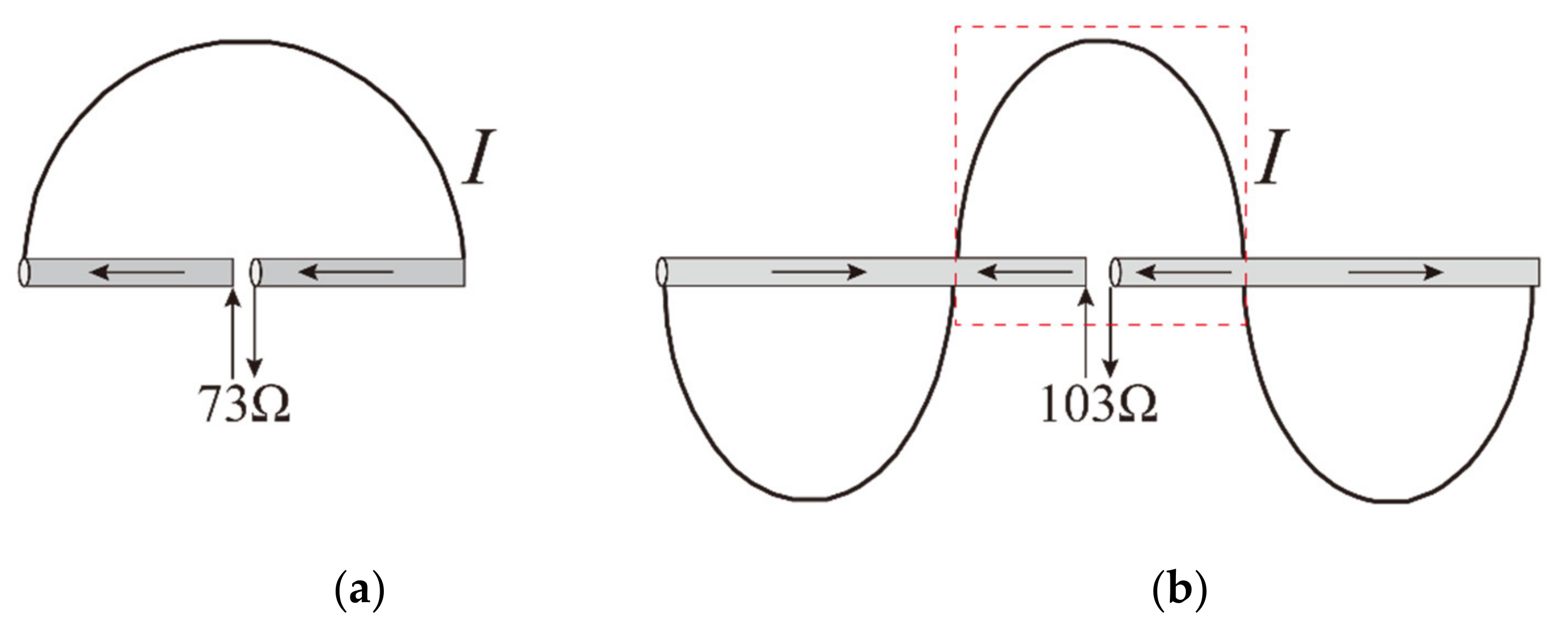
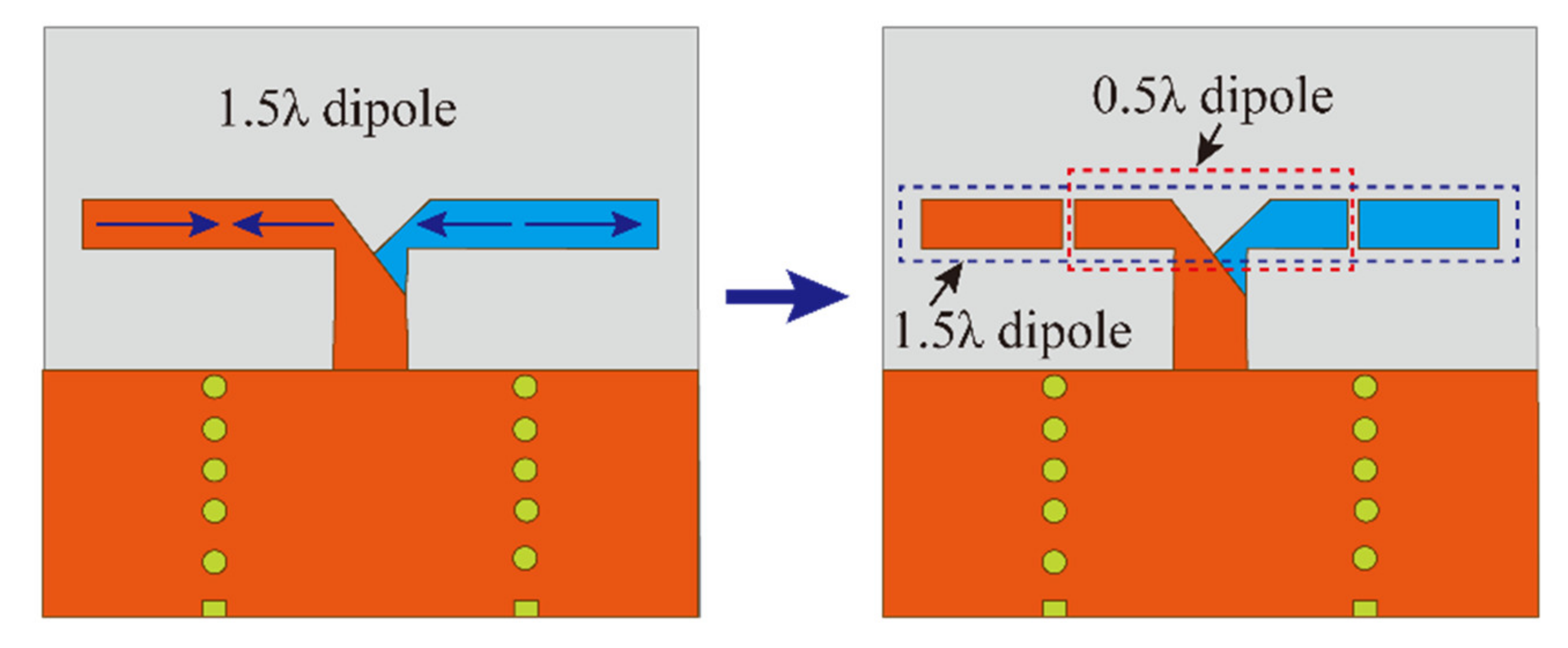
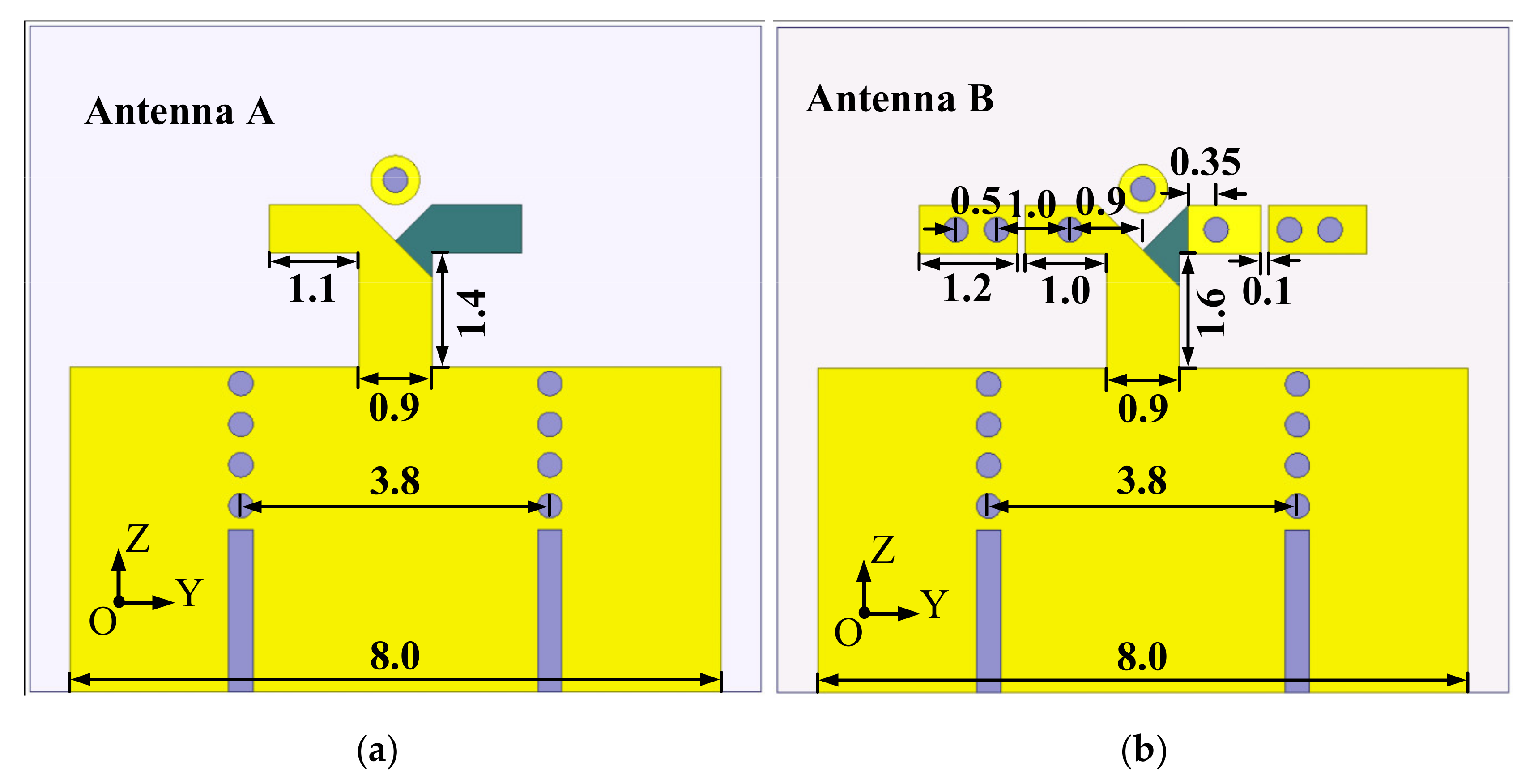

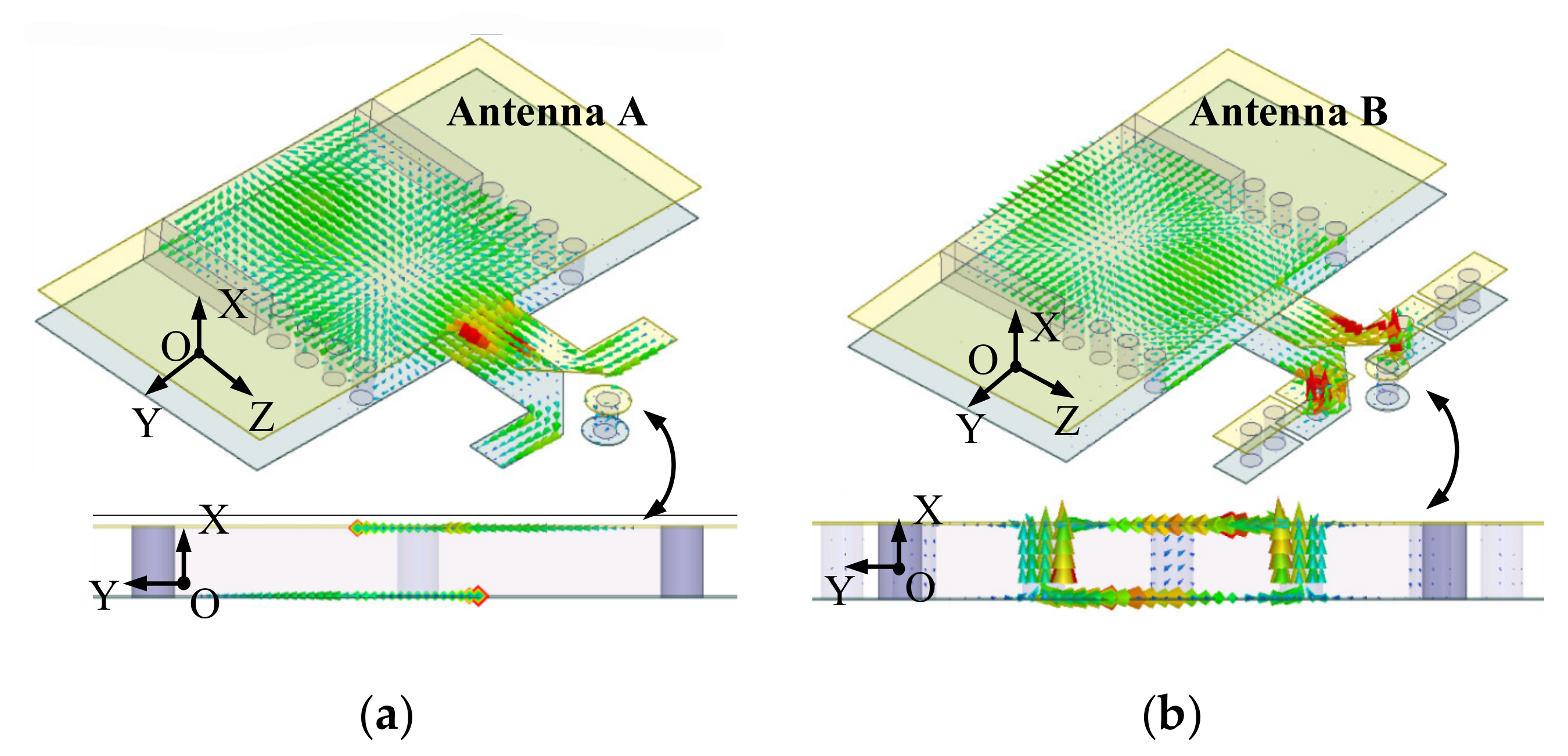


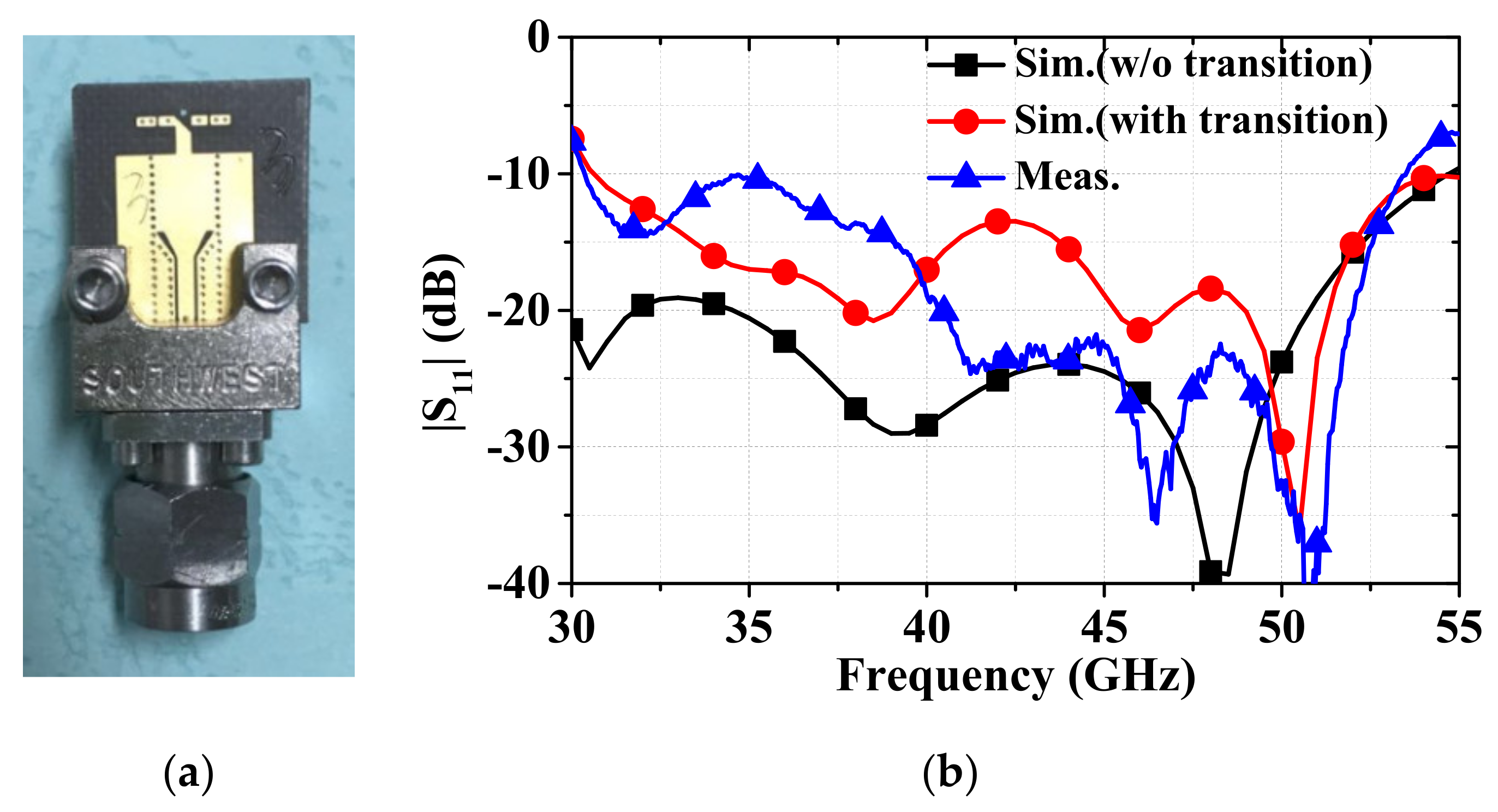
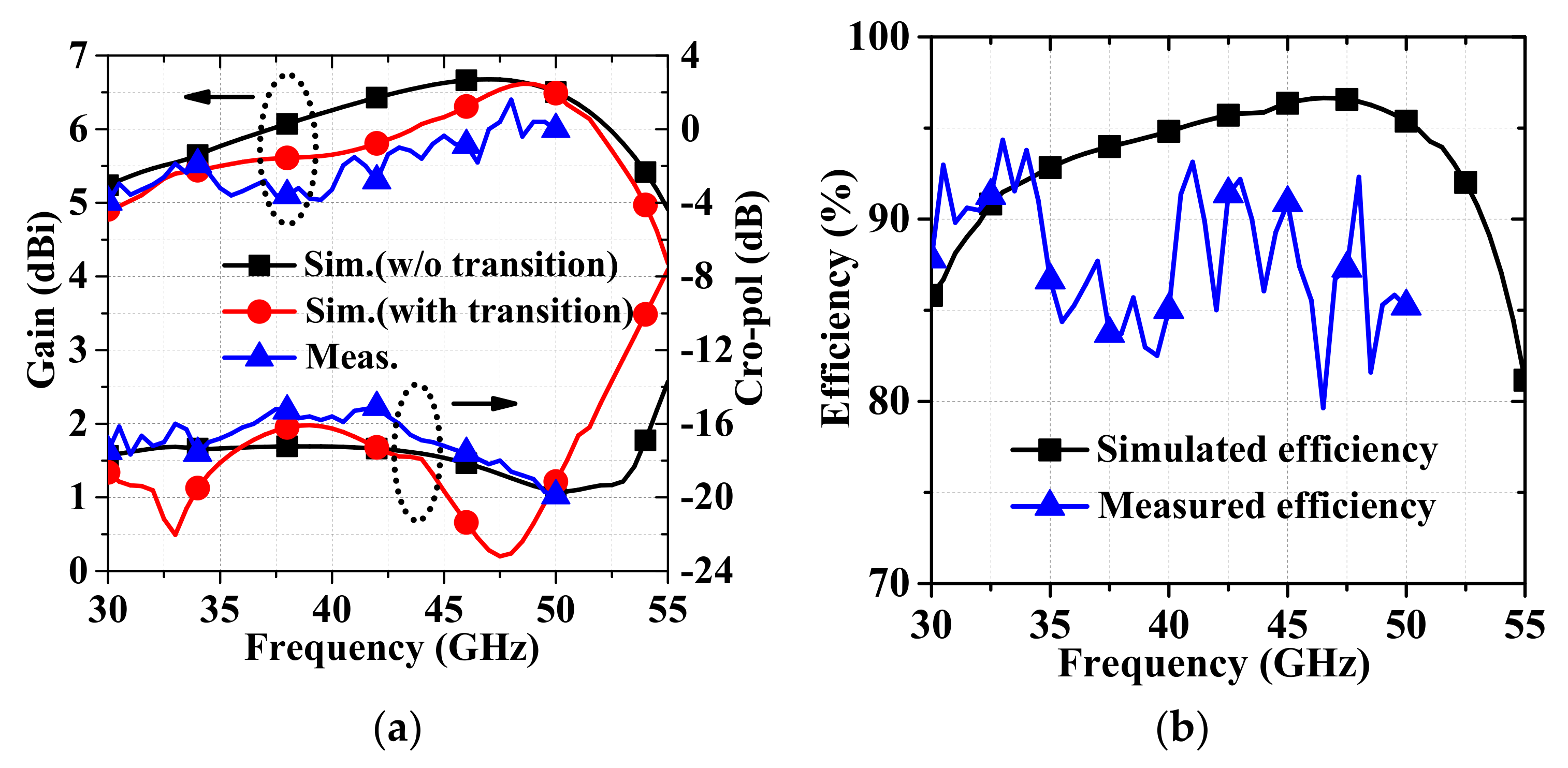

| 8 | 14 | 3.8 | 0.5 | 0.3 | 0.9 | 1.6 | 2.9 |
| 5.5 | 0.6 | 0.1 | 1.2 | 1.8 | 3.6 | 4.6 |
| Ref. | [8] | [9] | [11] | [12] * | [22] * | [23] | This Work |
| Center freq. (GHz) | 45 | 45 | 40 | 60 | 28 | 40 | 42 |
| Fabrication process | Single layer PCB | Single layer PCB | Single layer PCB | Single layer PCB | Two layer PCBs | Two layer PCBs | Single layer PCB |
| Imp. BW (%) | 13.6 (42.3–48.4 GHz) | 31.1 (36–50 GHz) | 36.2 (26.5–38.2 GHz) | 30 (50–68 GHz) | 17.5 (26–31 GHz) | 34.4 (33.5–47.4 GHz) | 55.7 (33.3–53.7 GHz) |
| |S11| (center freq.) | −20 dB | −18 dB | −15 dB | −19 dB | −25 dB | −11 dB | −25 dB |
| Gain (dBi) | 3.7–5.2 | 2.6–3.3 | 4.5–5.8 | 10.5–11.7 | 9.1 | 4.5–7 | 5.1–6.4 |
| 2.2/0.0009 | 2.2/0.0009 | 2.2/0.0009 | 3.38/0.0027 | 2.2/0.0009 | 2.2/0.0009 | 2.2/0.0009 | |
| Feeding network | SIW | SIW | Microstrip | Microstrip | SICL | SIDL | SIW |
| Cross polarization level (dB) | −7 dB | −25 dB | −15 dB | −15 dB | −20 dB | −10 dB | −15 dB |
| Size (mm3) | 6 × 26 × 0.508 | 5.5 × 38 × 0.25 | 10 × 30 × 0.25 | 9.2 × 10 × 0.2 | N. × N. × 0.608 | 13 × 20 × 0.608 | 11 × 14 × 0.508 |
| Max. Rad. Eff. | 82% | N.A. | 93% (Sim.) | N.A. | N.A. | N.A. | 80–95 |
Publisher’s Note: MDPI stays neutral with regard to jurisdictional claims in published maps and institutional affiliations. |
© 2022 by the authors. Licensee MDPI, Basel, Switzerland. This article is an open access article distributed under the terms and conditions of the Creative Commons Attribution (CC BY) license (https://creativecommons.org/licenses/by/4.0/).
Share and Cite
Xue, L.; Tan, Q.; Cheng, K.; Fan, K. A Wideband Folded Dipole Antenna with an Improved Cross-Polarization Level for Millimeter-Wave Applications. Appl. Sci. 2022, 12, 11291. https://doi.org/10.3390/app122111291
Xue L, Tan Q, Cheng K, Fan K. A Wideband Folded Dipole Antenna with an Improved Cross-Polarization Level for Millimeter-Wave Applications. Applied Sciences. 2022; 12(21):11291. https://doi.org/10.3390/app122111291
Chicago/Turabian StyleXue, Lianpeng, Qiangquan Tan, Ke Cheng, and Kuikui Fan. 2022. "A Wideband Folded Dipole Antenna with an Improved Cross-Polarization Level for Millimeter-Wave Applications" Applied Sciences 12, no. 21: 11291. https://doi.org/10.3390/app122111291
APA StyleXue, L., Tan, Q., Cheng, K., & Fan, K. (2022). A Wideband Folded Dipole Antenna with an Improved Cross-Polarization Level for Millimeter-Wave Applications. Applied Sciences, 12(21), 11291. https://doi.org/10.3390/app122111291







